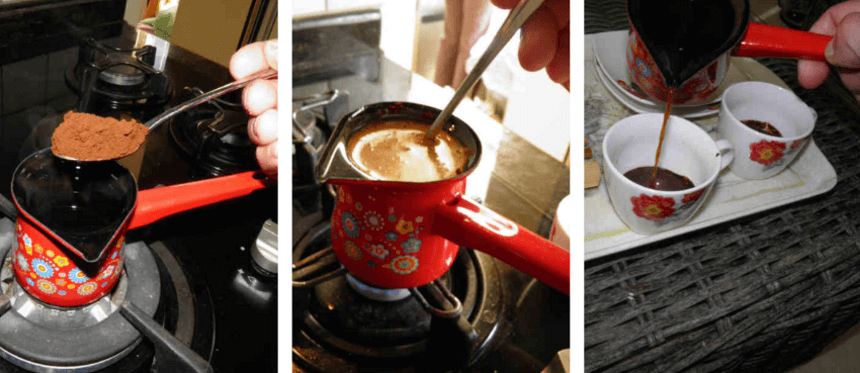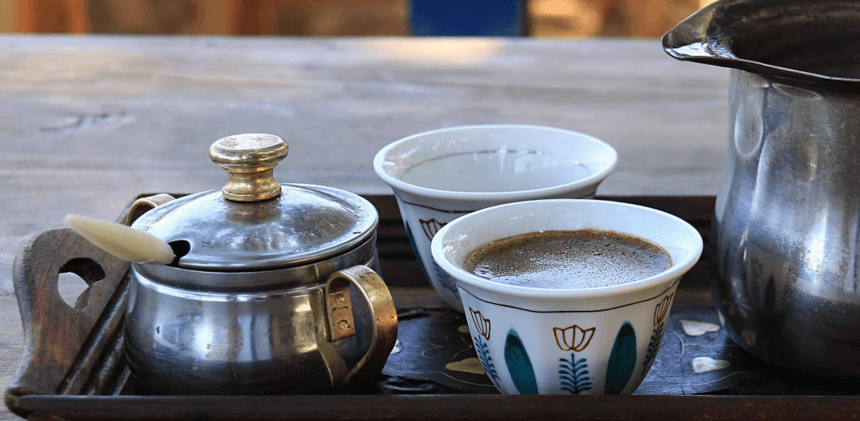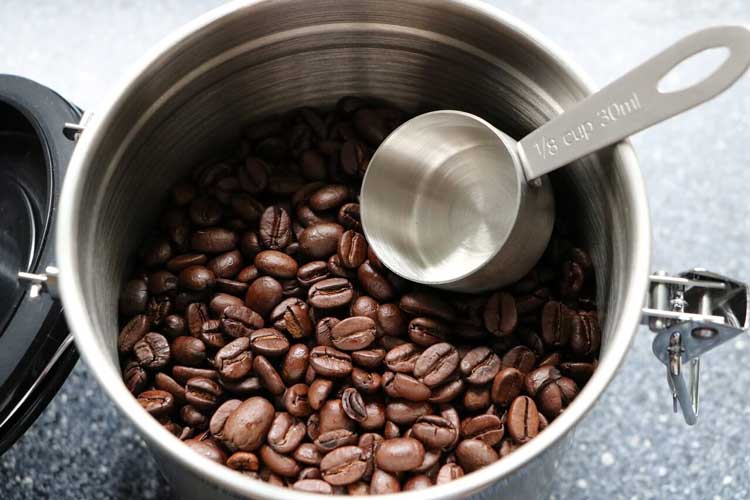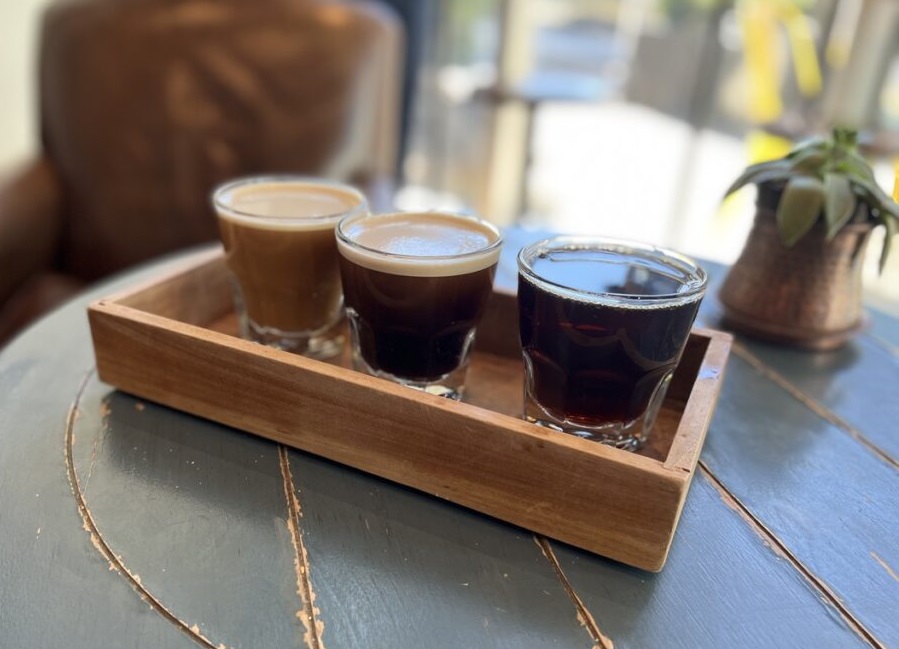

Lebanese people are very social, and this might sound strange to Americans who hardly have social breaks but it is not unusual to have guests visiting your home several times in a day, sometimes unannounced. During these visits, the host typically serves the guests Lebanese coffee to welcome them even if they are only staying for a few minutes.
Lebanese coffee is also known as Kahva, Kawha or Ahweh. It is black and strong coffee that is prepared in a similar fashion to Arabic coffee or Turkish coffee, made in batches of up to 5 servings and served in small shots like espresso.
Coffee is so popular in Lebanese culture that it is associated with their nationality. It is served all day long at work, in homes, restaurants and cafes.

What is Lebanese coffee? This is coffee that is brewed with finely ground dark roasted beans and cardamom powder or seeds for a spicy flavor. Sometimes, you add sugar. Lebanon usually uses cardamom to enrich the coffee flavor whereas musk or orange flower water is more common in Syria.
How do you make Lebanese coffee? You boil the fine grounds several times to extract flavor and then infuse cardamom and sugar into the water to produce dark, bitter and thick coffee that you serve in a demitasse cup.
Demitasse, which is half cup in French, refers to the classic white tiny cups that serve espresso, Turkish coffee and Greek coffee. Many cups are available with matching saucers to collect any dripping coffee and to carry the cup easily. The cups are made of ceramic, pottery or porcelain drinkware such as Miavva Mirra Porcelain Cups, a set of 6 cups that comes in gold or silver color.
The name ‘Lebanese coffee’ actually comes from the type of brewing you use. You roast premium Arabica beans to mix the dark and blond types and then grind them into fine powder to yield coffee with a rich body and delicious taste.
To learn how to make Arabic coffee or Lebanese coffee, you should know their caffeine content so you can adjust your daily consumption to safe levels that are not detrimental to your health.
The caffeine content of coffee depends on the type of coffee beans, the type of coffee, the method of roasting and the serving size. For example, a study Trusted Source Comparative evaluation of caffeine content in Arabian coffee with other caffeine beverages It is well documented that caffeine is the world’s most widely consumed drug with its main source found in coffee. academicjournals.org that compared the caffeine content of Turkish coffee and Arabian coffee found that a cup of Turkish coffee has the same caffeine content as 20 Arabian cups.
Many of us assume that darker roasts have a higher level of caffeine content because of their rich and strong flavor but lighter roasts actually have higher caffeine content, according to the National Coffee Association (NCA) Trusted Source Coffee Roast Guide Roasting is a heat process that turns coffee into the fragrant, dark brown beans we know and love. www.ncausa.org .
The taste of coffee depends on the type of coffee bean as well as the roasting, grinding and packaging process and the flavor of Lebanese coffee will vary according to the coffee brand. Some coffee producers prefer roasting at high temperature, some prefer lower temperature and then there are others who roast the beans by alternating between low and high temperatures.
Similarly, producers may opt for hot or cold grinding to represent their unique coffee flavor. Freshly ground coffee is of superior quality and we have the best manual coffee grinders to enjoy your favorite drink at home.

Next, grind the coffee beans into a very fine powder in a burr grinder to produce more surface area for optimal extraction of flavor.
Ibrik that is used in Lebanon to brew coffee is a small pot with a long and narrow handle hooked to the rim. Fill it with water and boil it. You may add sugar, if you wish, to the boiling water to create syrup.
After that, remove the ibrik and add ground coffee and cardamom powder or seeds to the water. Next, place the pot back and boil all the ingredients for a second and then allow the mixture to cool. Boil and then cool the ingredients twice more to extract the flavor while ensuring that the coffee does not overflow as it boils.
You may also use The Silk Road Trade ACI Series Coffee Pot to make 4 servings of Lebanese, Turkish and Arabic coffee.
Lebanese coffee is made in the same way as Arabic coffee but the former uses darker roast for a full bodied flavor whereas the latter uses lighter roast with higher caffeine content.
To make Lebanese or Turkish coffee, you will need the best Turkish coffee grinders and some of them include a complimentary bag of coffee which is a bonus.
The ingredients for Lebanese coffee are one espresso cup of water, cardamom and a half teaspoon of sugar. The key is to use a cup of water and a teaspoon of ground coffee for every cup of brewed coffee.
Put the water, ground coffee and sugar in a coffee pot and heat the ingredients to a boil. Next, remove the pot and cool it until the foaming recedes and then boil the ingredients and again after adding cardamom. Repeat the process three times. We allow the ingredients to cool before boiling them again to extract maximum flavor without overheating the coffee. The result is coffee with froth on top and thick sediment at the bottom.
As there is no filtration involved, allow the coffee grounds to settle for a few minutes before enjoying the drink.
You can also check out this video for detailed steps for making Lebanese coffee at home:
Pour the hot coffee into espresso cups placed on a tray and serve it with a glass of cold water.
In Lebanon, coffee grinds are used for future readings and advice on life decisions. Since Lebanese and Turkish coffee forms residue, leave a bit of coffee as you drink and then quickly turn the cup upside down so the coffee grounds lie on the coffee cup holder for the coffee cup reader to interpret the shapes.

You can serve Lebanese coffee with or without cardamom while Arabic coffee is normally served with dates. You may also serve it without sugar.
Caffeine has anti-oxidative properties and can lower the risk of mortality, especially in people with diabetes and chronic kidney disease, according to this study Trusted Source Caffeine as a Factor Influencing the Functioning of the Human Body—Friend or Foe? Nowadays, caffeine is one of the most commonly consumed substances, which presents in many plants and products. www.ncbi.nlm.nih.gov .
After brewing Lebanese coffee, allow the coffee grounds to settle before drinking it and leave a little of it in the cup after drinking to avoid drinking the sediment at the bottom.
You should always pair Lebanese coffee with the same amount of water. Put the water in a glass, cup or Brik, a jug with a spout to pour water into your mouth.
Coffee has a long history in Lebanon and there is a distinctive way of preparing the beans despite the coffee in the Middle East region sharing similar brewing methods. The Arabica beans are known for their smooth texture, delicate flavor and a fruity aroma that complements the cardamom spice used in Lebanese and Turkish coffee.
In Lebanon, coffee is a social norm that is used in almost all occasions, from refreshing your loved ones to breaking ice with strangers. It is typically served up last and some guests often use it as their cue to leave.
We have explained what type of beverage it is and how to drink Lebanese coffee. We have also included preparation and serving guides as well as a recipe to make Lebanese coffee at home.





